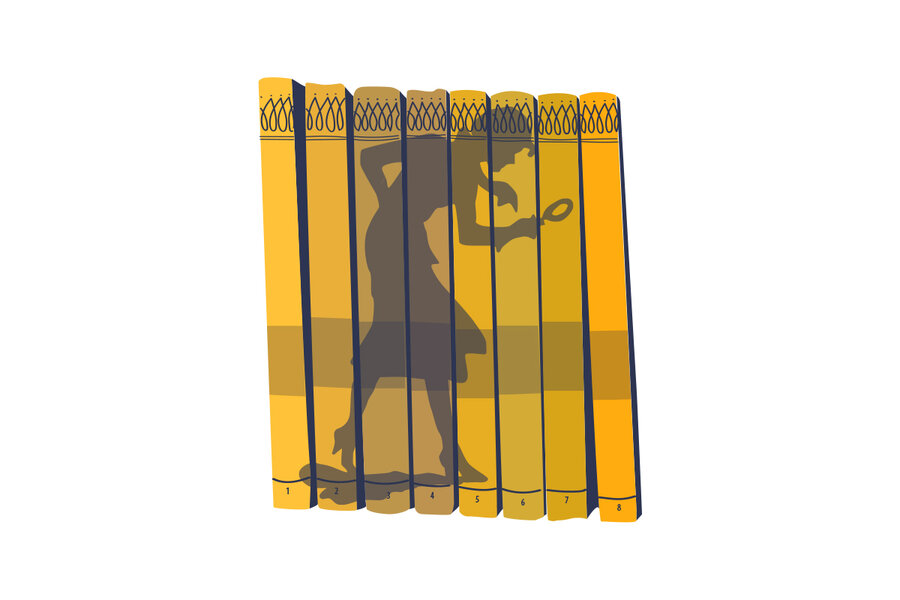Nancy Drew and the mystery of girl power
Loading...
My mother-in-law seemed slightly uncomfortable when she told me what she’d bought for my two young daughters, her only grandchildren.
“It’s Nancy Drew,” she said, avoiding eye contact. “I hope that’s OK.”
We both looked toward her bag, inside of which rested not just one Nancy Drew book but a set, the first five mysteries in the series – or at least the 1950s version of it. Nancy has had a number of iterations over the years.
I tried to be reassuring.
“Of course it’s OK!” I gushed. “I loved Nancy Drew when I was a kid!”
But to be honest, I wasn’t sure what I thought. How would my girls react to the young sleuth and her adventures with old clocks, haunted inns, and mysterious perfume bottles? They were just starting on chapter books, and while some classics seemed to click (we spent weeks pretending to live in a covered wagon, thanks to Laura Ingalls Wilder), their childhood literary exposure seemed, well, different than mine.
This wasn’t because of technology. We are a book family. But their books tend to be about kindness and equality, being nice to people who are different. Having self-confidence. They had read nothing to prepare them for gangsters, car wrecks, and grown-ups who lied, I thought, as I stared down at those Nancy Drews.
When I was a child, these harder-edged topics were the norm. Almost every book I read had a bad guy or mean kid or haughty wealthy people who needed a comeuppance. There were orphans without sparkly dresses or ice powers. Mothers died and stepmothers sold kids into slavery. The good characters were good because of the way they acted when faced with negatives – ill treatment, ill circumstances, ill fortune.
I had tried to protect my girls from the dark corners of the world. I wanted only positive role models, only sunshine. Through this lens, many of my old favorites didn’t make the cut. “The Secret Garden”? Within the first few pages there is cholera, death, and an emotionally distant mother, not to mention a colonial child throwing a racist temper tantrum. Babar? Almost immediately his mother is shot by a “wicked” hunter and baby Babar is left sobbing. Nope and nope.
Nancy Drew?
I understood why my mother-in-law was worried. Not only does the old-school Nancy have some outright violent encounters (not a book goes by where her life isn’t threatened by a sinister male), but a few decades had left her on some shaky feminist ground.
Why, at 18, wasn’t Nancy in college? Why did we have to hear about her “slim figure” so much, or her “titian hair,” accentuated by the green fabric of her summer suit? Why, with his wife gone, does Carson Drew leave his daughter alone so much? And who buys an 18-year-old a blue convertible? Don’t even get me started on boyfriend Ned Nickerson.
This was everything I was keeping from my daughters, praying they could grow up proud and strong, untouched by a culture that sends toxic messages about violence, fear, and who and what young girls should become.
And yet ... the books were tantalizing, their lined-up yellow spines like a light in the window. I was as curious as my girls.
So one afternoon we sat on the couch and read. Within pages, my kids were riveted. Or, to use the language of Carolyn Keene, pseudonym for the authors of the mystery series, “presently, my daughters became entranced.”
So was I. Nancy was a superhero. She saved friends from drowning, faced down thieves, and drove in car chases. She could scuba dive better than CIA agents. She reassured the grieving and wasn’t afraid (despite shrieks of warning from the first grader on the sofa) to venture into dark and abandoned places. Yes, there was a lot of talk about outfits, but she was all girl power.
And girl power, I saw, meant more to my daughters when it was facing off with something real. It was fiercest when its opponents were fierce, too.
A week into Nancy Drew, I realized something. Even with all of the critiques one could level against the young detective – the racial and financial privilege, the constant brushing of hair “until it shined” – there was a sparkle she was passing along to my daughters. Both girls were acting tougher, pretending to rescue friends, spy on bad guys, and escape from traps.
I was feeling stronger, too. I still love our sweet children’s books about being brave, showing kindness, and accepting others. But Nancy had solved a troubling mystery for me. She had helped me discover that my girls will go out into the world as the powerful, confident, and morally centered young women they are. And she had helped me uncover the world again, with strength and not fear.








